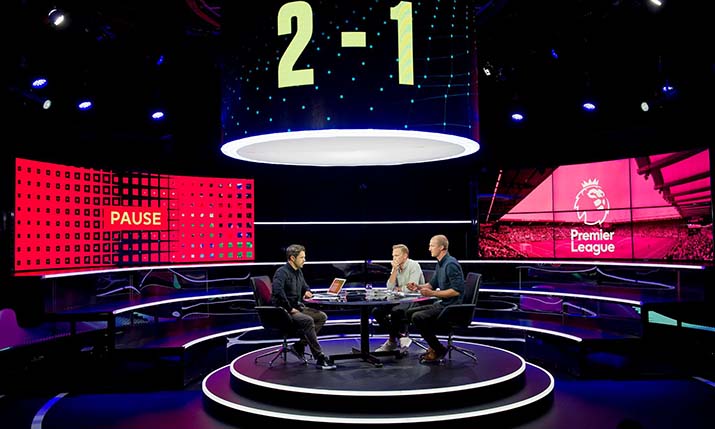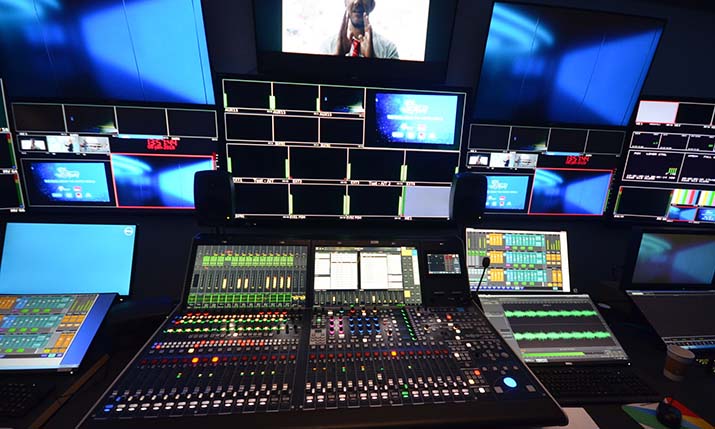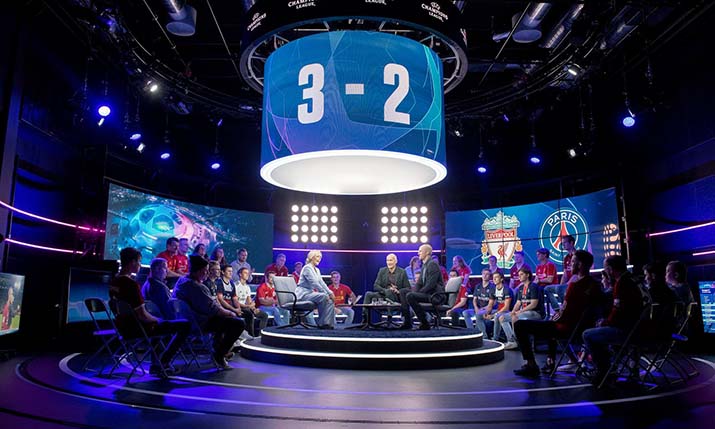Ambition versus success: TV 2 on balancing its goals to be the number one sports broadcaster in Norway

In sports coverage, TV 2’s main focus is English Premier League football, which is very popular in Norway and is the broadcaster’s biggest draw for its over the top (OTT) services
Norway’s TV 2 has set its sights on becoming the largest broadcaster of sport in the country. It has accumulated a plethora of sports rights which will see it more than tripling its sports broadcasts in the next year.
However, the broadcaster needs to be cunning in how it produces this bevvy of content to provide maximum coverage, while bearing in mind its viewership is limited to the country’s 5.5 million residents, making the cost of production a crucial factor in balancing the scale between ambition and success.
On the plan to become the home of Norwegian sport, Jens Cornelius Knudsen, head of production models and partnerships at TV 2, tells SVG Europe: “We have acquired quite a lot of Norwegian sports rights. We have the top five divisions of football; four divisions for the men, and the top two divisions for the women. We’ve also acquired handball, which is big in Norway, and so we have acquired the top and second divisions there, both male and female. And we’ve extended our national hockey deal, so that runs for another eight years.
“We’re operating in a country with 5.5 million people so the production has to be extremely efficient… They’re sitting there in a very tailored workflow for efficiency and that enables us to produce these 225 hockey games for a sensible amount [of money], considering the number of people we have living in this cold country”
“On top of that, we’ve actually started broadcasting basketball, volleyball, and floorball, which are more of the niche sports in Norway,” he continues. “And on top of that, we also have the Champions League, La Liga, World Championship, European championship, qualification games, and we share winter sports rights like biathlon and skiing with NRK, the state broadcaster.”
Triple the coverage
The coming year will see TV 2 producing a massively enhanced number of games from across its rights portfolio. Notes Knudsen: “So we normally have around 300 multi-camera sports productions in Norway, annually. Starting this year we’re increasing that to about 1,050 sports productions.”
On where TV 2 stands today on domination of the Norwegian sports broadcast industry, Knudsen says it is the top in terms of hours. He claims: “I would say [TV 2 is] the top [sports broadcaster], because we have the Norwegian rights, we have Champions League, we have La Liga, we share the Euro and the World Championship with NRK, and we share Biathlon with NRK, and we have Switzerland and Norway’s winter sports together. So I think that definitely [makes us] the largest sports broadcaster in hours. Due to the multiple rights and efficient production methods [we use], we’re also capable of becoming a large sports entity when it comes to number of consumers per day. That’s the plan.”
Adds Knudsen: “We’re operating in a country with 5.5 million people so the production has to be extremely efficient. For our hockey production that we currently do internally – that [service provider] DMC is going to take over – we do 225 games as a remote production today, centralised, and we do 45 as an OB production. For the 225 games that we produce internally, NEP has camera operators on site, that’s say a two camera production, plus two ceiling-mounted cameras over the goal. We take all those four feeds back home then using VMix and SingularLive, we’ve been able to build a workflow internally where one person is the director, the switcher, they run slow motion, they do audio, and they do graphics.
“They’re sitting there in a very tailored workflow for efficiency and that enables us to produce these 225 hockey games for a sensible amount [of money], considering the number of people we have living in this cold country,” Knudsen states.

A Lawo mc2 56 console that was fully assimilated into the all-IP facilities at TV 2’s base in Bergen, in February 2021
Two partners in crime
TV 2 has taken on two partners, NEP Norway, with whom it has a long-standing relationship, and Sweden-based DMC in Sports, to help it produce its sports content, because says Knudsen, “I want to break up the monopoly situation we have in Norway and we also wanted to have competition in the market so the RFP we sent out, we had three companies [respond] and we selected NEP and DMC “.
He adds: “Also, because when you have two people working with you, there tends to be more innovation between them.
“In order to do this properly and in a sustainable way, we’ve made a deal with NEP and DMC,” continues Knudsen. “NEP will do all the premium football, the elite series, and they also have the larger games in the female division and the second division that [NEP and DMC will] split. [NEP and DMC are] sharing a lot of the other sports [productions]. DMC is doing some football, a lot of smaller football games, and they do indoor sports.”
Comments Morten Aass, president at NEP Nordic, on working with TV 2: “We at NEP look forward to continuing in the production role of Norwegian top football. With this agreement, we consolidate our position as the Nordic region’s leading player in TV production. New times require new production methods, and we have teamed up with NFF and TV 2 for an ambitious climate-neutral form of production. This will be a very exciting and innovative boost for the industry and for us as a company.”

Studio A at TV 2. Football is a mainstay of the broadcaster’s primary and OTT output, and is driving its work in object-based sound
New player in Norway
Commenting on DMC in Sports, Knudsen says: “As of today, they’re not present in Norway. They’re getting established in Norway because of the deal we’ve made with them. They’ve already rented a space, and they have ordered the equipment, and they’re currently doing their systems design, and they’ve ordered cameras and an OB truck, and now they’re doing their final system designs with Broadcast Solutions.”
“The whole idea is, the traditional arena production, we want out. We want smaller trucks, and we want to centralise”
DMC will remote produce approximately 600 games per year in a wide range of sports, including football, ice hockey, handball, volleyball, floorball, and basketball. DMC will primarily focus on productions featuring two to eight onsite cameras and utilising its expertise in remote productions built upon their state-of-the-art broadcast technology, with a strong focus on sustainability. It is set to deliver a modern solution featuring TV 2’s centralised production facilities.
“Our approach is built upon innovative, modern, environmentally friendly, and cost-effective production solutions, which is central to our new partnership with TV2,” says Daniel Franck, CEO and founder of DMC in Sports. “We are eager to build a new flagship studio in Oslo and provide a cutting edge production environment across a wide spectrum of sports. And as the remote production technology continues to drive an industrial paradigm shift, our partnership with TV2 will streamline their ability to connect Norwegian audiences with the sports they love through their high quality storytelling and comprehensive sports coverage.”
It will also be involved in establishing and managing the technical implementation for the introduction of centralised VAR capabilities for Eliteserien with the federation in the upcoming rights period.
Knudsen explains: “Another thing that we’re achieving is when you’re centralising and bringing all these signals into the same building, we can also then create a centralised VAR centre. DMC will be the hub for the centralised VAR centre; we’re building eight VAR desks, and the supervisor, and they’ll have their own MCR for the other productions anyway, and then we’ll have the VAR technicians in the arena.”
Knudsen goes on: “The idea is to create a home turf for Norwegian sports, so we’re doing multi cam regular arena sports production on the upper level of each sport, and then we’re going to slowly introduce artificial intelligence (AI) on the lower divisions there,” he notes, with AI being utilised to enable a more hands-off production for lower tier sports.
On AI-produced games, TV 2 is working with a company called MyGame, which it is a co-owner of. MyGame is a new streaming platform for Norwegian grassroots sports which uses AI-driven cameras to produce matches from all over Norway. It enables parents, family, friends and fans to follow their favourite players and teams on the TV 2 over the top (OTT) platform.
In addition, MyGame has entered into exclusive rights agreements with the Norwegian Handball Association, the Norwegian Ice Hockey Association, the Norwegian Basketball Association, the Norwegian Volleyball Association and the Norwegian Bandy Association for floorball. It is working closely with TV 2 over their shared rights permissions.
Brand new centralised production
Knudsen says: “The idea is now to create a centralised production for these 1,050 productions. So the whole idea is, the traditional arena production, we want out. We want smaller trucks, and we want to centralise. The centralisation is that we are connecting the stadiums so for football it’ll be minimum one gig, maximum 10 gigs, and we take all that back to centralised production centres, and we have centralised the galleries. We also tend to automate a lot using Mosart from Vizrt, which was created internally at TV2, because we wanted to automate more [to enable this type of production].”
He goes on: “Our goal is to centralise the production [of all these sports and matches], meaning instead of calling it remote [production], I use the word ‘centralised’. So DMC is building capacity for eight control rooms in Oslo, and NEP is extending the number of control rooms they have.”
This will greatly improve efficiency of producing such a vast amount of sports events, lower the cost of production overall, and improve production sustainability says Knudsen. “The idea is to keep [as many people as possible] in the control room in Oslo, hence have less people that travel to the arenas. What we’re achieving here is to keep these guys [in the crew] at home, so the main audio [operator], camera control, and more. We’re going to have a lot of local photographers, the technical lead, and we have the floor manager. So we’re cutting down [on travel] tremendously,” he continues.
“So we’ll have much smaller trucks at the arena with the cameras, and the tripods, and all this, and we will use a lot more local crew [near to games],” says Knudsen.
However, he adds that because of the large increase in the number of games being covered by the broadcaster, and the fact that the Norwegian TV industry lost a lot of freelance crew during the pandemic due to the lack of work, TV 2 is now in a recruitment drive to bring in more directors, more slo mo operators for VAR requirements, graphics and others. Knudsen comments: “The pandemic meant that in Norway we lost a lot of our crews, because they took up different jobs”.
“We’re going to have a big recruitment and training so that we’re able to use more local people, [and therefore] have less people traveling. Because if I can keep the gallery at home, that’s between four and seven people,” he continues.
“We have around 600 games that require between five and 13 cameras, so if I’m able to keep four to seven people on each of those games in Oslo, we’ll have a lot less travel, a lot less wear and tear on our crew – because remember Norway’s a very long country and the days to cover a match are very long also – and instead [crew] can just spend half an hour traveling to the centralised control rooms, do the game – maybe two gigs – and then home for dinner.”
